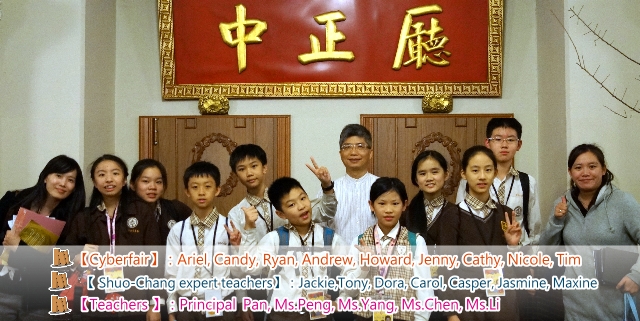|
Watching Cross Talks ‘2015 Story of the City Part Three’ by the T.Q.T.
I still remembered during our briefing to the principal, he said, “Since you are going to research on the art of shuochang, do not limit yourself to just learning from teachers and students at our school. If possible, go and experience a show performed by professionals!” After finishing Hand-In-Hand shuochang learning lessons, we went to Zhongshan Hall with our student shuochang expert teachers for a professional cross talks show performed by the Taipei Quyi Team (T.Q.T.). The trip turned out to be very fruitful because we managed to complete two sets of surveys. One set was about how well do people know about the art of shuochang, and the other set was about how much the audience enjoyed the show. Event Profile
Research Survey
Design of Survey
There are two sets of survey for this research. One set is about how well do people know about the art of shuochang, and the other set is about how much the audience enjoyed the show. Since we conducted the first survey before the show started when it was about to get dark, so we decided to use tablets for this survey. After the questions were finalized, we used Google Forms to type out the survey. Prepare for the SurveyOn the day of the event, we met up in front of the computer classroom to practice giving out surveys. We studied different types of shuochang beforehand so when we conduct the survey, we would be able to explain to people who take the survey what each form of shuochang was about.
Conduct the SurveyBefore the gate opened at 6:00 p.m., we conducted the first set of survey outside Zhongshan Hall. In places where there was little lighting, our tablets team would take charge there. In places with sufficient lighting, the team with paper based surveys would take charge. With two teams conducting surveys, our efficiency got better!
When it was time to enter, we stood by the entrance to give out paper based surveys to the entering audience. During the intermission, we did a few more surveys. After the show was over, we raised a sign that read ‘Yu-Tsai Survey Drop-Off’ and collected all the surveys to complete today’s visit to Zhongshan Hall.
Show Time
This was our first time watching a professional cross talks performance. The show was entertaining and filled with different forms of shuochang in it. Our eyes went wide open, and we learned a lot from the show! We watched the following forms of shuochang tonight: Fast clapper talks:performed by the new generation of shuochang artists from T.Q.T. Group cross talks:Jin Fei and Chen Yi, both are from Beijing, are the rising stars in the cross talks business. Their performance style blends in traditional and modern elements. The two performed cross talks duo seamlessly, and they even included storytelling with clappers in their performance. Their storytelling with clappers went so fast that we almost forgot to breathe. Group cross talks:the show was based on an animation that discussed about human emotion, performed by Liu Yue-Ti, Huang Yi-Hao, Chen Qing-Sheng, Wu Pei-Ling, Wei, Zhu-Yao, and Zhu De-Gang. Their group cross talks performance went on like a play, and its jokes made the audience laugh very hard.
Cross talks duo:Ying Ning and Cui Jun, both are from Beijing, have done an extraordinary job modifying classical verses and couplets to fit them into their modern cross talks performance. Their literary proficiency is simply amazing. Cross talks duo:Xie Xiao-Ling and Zhu De-Gang did more than just talking, they even sang. Furthermore, they didn’t just sing pop music, they sang classical tunes. Besides Mandarin, the duo even performed in Hakka dialect. From their performance, we saw how versatile cross talks performances can be. Pingshu:Director Yeh Yi Chun of T.Q.T. performed pingshu, which is a form of storytelling from northern China. Pingshu is performed much like storytelling, Director Yeh changed characters throughout the performance. One major difference we have noticed about pingshu is that it is performed using a northern dialect, so many of us had trouble understanding the story. We had to rely on Director Yeh’s changes in speed of talking, intonation, and sound of Pipa accompaniment to feel the flow of her performance. Cross talks duo:Wang Qian-Xiang and Li Zeng-Rui are both China’s top-class performers. They have been performing together for 55 years, and they are known as the ‘golden pair’ in the cross talks business. Their cross talks performance garnered enthusiastic cheers and applauses from the audience. However, due to our limited linguistic capabilities, we did not understand much of their performance. The best we could do was feeling their performance with the audience to experience the charisma of the two national cross talks masters. Highlights after the show
Today’s show was filled with one highlight after another, and we could not get enough of it. The art of shuochang is truly versatile, and its performing possibilities are endless. After watching the show, we came up with ideas like more jokes or musical accompaniment to make our performance better. After the curtain call, Ms. Li took us back stage to meet and take pictures with the shuochang masters who performed tonight. Text: Tim, the Original Artsy Shuochang Posse │ Pictures: the Original Artsy Shuochang Posse, T.Q.T. program |
|||||||||||||||||||||||
 |













